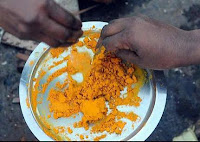LORD GANESHA AND
HIS SANSKRIT NAMES
 www.boldsky.com - Lord Ganesha is given prime importance among the Panch Devtas. The Panch Devtas are Lord Ganesha, Vishnu, Shiva, Shakti and Surya. In Hindu mythology, Panch Devtas together makes the Brahman (universe), which is supreme and absolute. Lord Ganesha is the son of lord Shiva and the God is given the first honour of worship in Hinduism. Before undertaking anything auspicious Hindus offer prayers to Lord Ganesha. In Hindu families it is a tradition to take 10 Sanskrit names of Lord Ganesha before undertaking any new initiative. So, here are the 10 Sanskrit names of the Lord Ganesha with their meanings.
www.boldsky.com - Lord Ganesha is given prime importance among the Panch Devtas. The Panch Devtas are Lord Ganesha, Vishnu, Shiva, Shakti and Surya. In Hindu mythology, Panch Devtas together makes the Brahman (universe), which is supreme and absolute. Lord Ganesha is the son of lord Shiva and the God is given the first honour of worship in Hinduism. Before undertaking anything auspicious Hindus offer prayers to Lord Ganesha. In Hindu families it is a tradition to take 10 Sanskrit names of Lord Ganesha before undertaking any new initiative. So, here are the 10 Sanskrit names of the Lord Ganesha with their meanings. 1. Sumukh: This represents one who has a beautiful face. The idol of lord Ganesha is considered very beautiful. Though, Ganesha's small eyes signify seriousness. Long nose and his flat long ears reflects his wisdom and intellect because by means of them he listens to the complaints and grievances of his devotees. 2. Ek danta: This means the one who has one tooth. There is a story behind the reason why Ganesha is called 'ek danta'.
 3. Kapil: Cow is known as Kapila. The priests believed that as cow gives milk to make life of a man healthy, similarly, Lord Ganesha gives knowledge and wisdom that keeps man happy. 4. Gajakarna: 'Gaja' mean elephant and 'karna' means ears. Ganesha has ears of an elephant and therefore he is known as Gajakarna. 5. Lambodar: Lambodar means the one who has big belly. 6. Vikat: It means ferocious and dreadful. Lord Ganesha stands firmly to defeat all the evils. So, he is also known as Vikat. 7. Vighnanash: Lord Ganesha is believed to be the destroyer of all evil and calamities. Hence, he is known as Vighnanash. 8. Dhoomra Ketu: Dhoomra Ketu means agni or fire. Lord Ganesha destroys all hindrance which comes in the way of mankind.
3. Kapil: Cow is known as Kapila. The priests believed that as cow gives milk to make life of a man healthy, similarly, Lord Ganesha gives knowledge and wisdom that keeps man happy. 4. Gajakarna: 'Gaja' mean elephant and 'karna' means ears. Ganesha has ears of an elephant and therefore he is known as Gajakarna. 5. Lambodar: Lambodar means the one who has big belly. 6. Vikat: It means ferocious and dreadful. Lord Ganesha stands firmly to defeat all the evils. So, he is also known as Vikat. 7. Vighnanash: Lord Ganesha is believed to be the destroyer of all evil and calamities. Hence, he is known as Vighnanash. 8. Dhoomra Ketu: Dhoomra Ketu means agni or fire. Lord Ganesha destroys all hindrance which comes in the way of mankind.9. Ganadhyaksha: It means controller or a guru. As Hindu mythology believes that Lord Ganesha controls all human beings, demons, vedas etc. So, he is also known as Ganadhyaksha. 10. Bhalchandra: This mean the one who has moon on his head. Moon signifies the Universe, therefore Ganesha is also known as Bhalchandra.
WHAT DO THE VEDIC TEACHINGS TELL US?
 The elephant head of Lord Ganesha signifies the highest intelligence, buddhi. It represents the largest brain matter. The trunk of Lord Ganesha signifies the discretionary power. He can pick up a needle from a heap of grass. The large ears of Lord Ganesha signify the importance of hearing - to accept what is good and reject what is not useful to us. The small eyes of Lord Ganesha symbolize concentration and the power to focus our attention on what we should while shutting out the rest. The Vedas of Lord Ganesha signify the importance of knowledge in our lives. ... In the traditional Hindu temple, the worship ceremonies are conducted with an organized set of rituals. The temple priest usually begins the ceremony by offering a prayer to Lord Ganesha that all obstacles may be removed.
The elephant head of Lord Ganesha signifies the highest intelligence, buddhi. It represents the largest brain matter. The trunk of Lord Ganesha signifies the discretionary power. He can pick up a needle from a heap of grass. The large ears of Lord Ganesha signify the importance of hearing - to accept what is good and reject what is not useful to us. The small eyes of Lord Ganesha symbolize concentration and the power to focus our attention on what we should while shutting out the rest. The Vedas of Lord Ganesha signify the importance of knowledge in our lives. ... In the traditional Hindu temple, the worship ceremonies are conducted with an organized set of rituals. The temple priest usually begins the ceremony by offering a prayer to Lord Ganesha that all obstacles may be removed.
Dr. Hiro Badlani:
“Hinduism - Path of the Ancient Wisdom”
Chapter 52 “Symbols and Icons in Hinduism”
Chapter 53 “Hindu Customs” - http://hinduismpath.com/
“Hinduism - Path of the Ancient Wisdom”
Chapter 52 “Symbols and Icons in Hinduism”
Chapter 53 “Hindu Customs” - http://hinduismpath.com/
Published by dasavatara das - "Vedic Views on World News"
http://www.vedicviews-worldnews.blogspot.com.ar/
http://www.vedicviews-worldnews.blogspot.com.ar/




.jpg)
.jpg)

.jpg)



















.jpg)